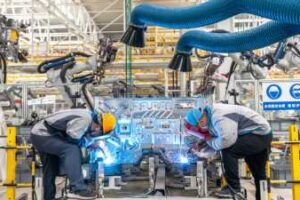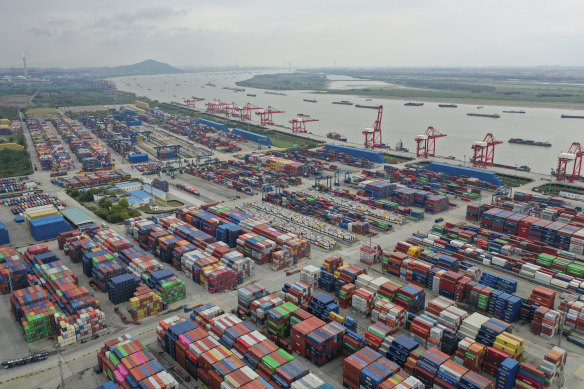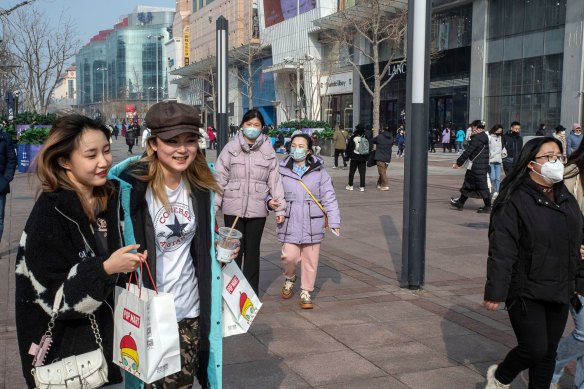China’s exports are crashing. Is this the end of the world’s factory?

Save articles for later
Add articles to your saved list and come back to them any time.
China’s exports plunged and its imports tumbled in July in the country’s worst trade performance since the onset of the pandemic in 2020. How much of that is due to its domestic economy and how much to structural changes in the global economy are the key questions that will define its future.
Exports were down 14.5 per cent in July, the third consecutive monthly fall, and imports fell 12.4 per cent. While there are some base effects – China’s export performance in July last year was a record – the export numbers were the lowest since February 2020.
The Nanjing container port. China’s exports crashed in July.Credit: AP
Moreover, the decline in exports was broad-based and against all of China’s major trading partners, with 20 per cent-plus falls in exports to the US, Europe and South-East Asia.
The lower imports might reflect lower commodity prices, but are also being driven by the weakness of demand and consumption in China’s domestic economy, which has been increasingly evident this year as the initial bounce from last year’s harsh zero-COVID policy has petered out.
There are a number of moving parts to the explanation for the sudden spluttering of an economy that has been a global powerhouse in recent decades, and whose trade performance boomed during the pandemic. Some of them are, in a sense, cyclical – but others are more ominous and point to structural changes occurring within China, and in global trade patterns.
China profited from the first phase of the pandemic as governments elsewhere showered their consumers and businesses with cash, and ultra-low-to-negative interest rates provided another windfall. Western consumers splashed out and China, the world’s manufacturing platform, benefited greatly.
The larger question mark over the trend within China’s exports is the extent to which it reflects structural change and the emerging reversal of the globalisation that has powered China’s economy for more than a quarter of a century.
That excess spending capacity has steadily dwindled as the pandemic programs ended and central banks in the world’s major economies began ratcheting up interest rates and exerting increasing pressure on household and business finances to combat a massive outbreak of inflation.
China’s factories, which had geared up to meet the boom, were left with excess capacity even as the severe lockdowns within China last year disrupted domestic activity and hollowed out their own finances.
Beijing’s crackdowns on the private sector – property companies, technology firms, online educators and ride-sharing companies – also unnerved entrepreneurs.
Very recent efforts by the authorities to convince entrepreneurs that Xi Jinping has reversed course and will treat them equally to the state-owned enterprises he previously favoured have yet to have any discernable impact: private companies want to see whether the rhetoric – the list of 31 measures Beijing says it will implement to help them – is backed up with actual action.
Chinese consumers, battered by the lockdowns and by the collapse of China’s property sector, are just as cautious. They are focused on conserving their savings rather than spending and producing the boost to consumption that the central authorities know they need to generate strong enough economic growth to meet their GDP growth target this year of about 5 per cent.
Battered by the lockdowns and the collapse of China’s property sector, China’s consumers are cautious.Credit: Bloomberg
So, there are some domestic strands to the explanation for the weakening import side of the trade equation, while part of the explanation for the falling exports would be the slowing of global economic growth and demand for China’s products, caused by the tightening of monetary policies in advanced economies and the economic impact of the war in Ukraine.
(The one shiny line item in the export numbers was a 52 per cent increase in exports to Russia, although that was down on the 90 per cent increase in June and the 153 per cent increase in April.)
The larger question mark over the trend within China’s exports is the extent to which it reflects structural change and the emerging reversal of the globalisation that has powered China’s economy for more than a quarter of a century.
The pandemic and the increase in tensions between China and the West, led by the United States, have had a significant effect on trade: not one that will help China to rebound from its current economic slowdown – and they will increasingly continue to do so.
The pandemic’s impact on global supply chains centred on China and exposed the vulnerability of other economies to interruptions to the quite fragile international supply and distribution networks.
In response, there is a significant “re-shoring” of critical activity occurring, either spontaneously by companies scarred by their pandemic experience or in response to governments’ urging and incentives.
The tariff war between the US and China that started during the pre-pandemic years of the Trump presidency has morphed into a broader and more sophisticated response by the US and increasingly its allies to Xi’s geopolitical and military ambitions.
The Trump tariffs remain in place (along with China’s tit-for-tat responses), but restrictions on China’s access to advanced semiconductors and other advanced technologies, and massive incentives in the US and Europe for investment in technologies and infrastructure to reduce their dependence on China (and diminish China’s capabilities in the process), are redirecting global investment flows away from China.
It’s not surprising that Mexico and Canada have displaced China as the major exporters to the US, or that exports from countries like Vietnam and Thailand have grown significantly as multinationals seek to diversify their supply bases (and some Chinese companies seek to circumvent the tariffs).
Nor is it surprising that, even as Beijing is sending its trade emissaries to Europe and wooing foreign private equity firms and other foreign investors to signal its openness to foreign investment, the latest data released on Friday shows foreign direct investment slumped to a 25-year low in the June quarter, and is now down almost 90 per cent from the same quarter last year.
The prospect of a continuing slowdown in the advanced economies and even the shallow recessions that seem likely in some of them means there is probably no near-term external source to reignite China’s growth. And the underlying trend that has developed in just a few years towards “deglobalisation,” or “de-risking” as the Europeans and Americans now describe it (to avoid accusations that they are trying to “decouple” their economies from China’s) will weigh on China’s growth rate for the foreseeable future.
Beijing seems reluctant to shovel cash at households to try to boost consumption, perhaps because it fears they will save rather than spend it. Nor does it appear to want to have to resort to the large-scale infrastructure and property-focused (and wasteful) stimulus programs of its past even though there is a serious threat of deflation developing within the economy.
The changes occurring within and outside China’s economy point to more subdued growth (at best) than China has historically enjoyed, at least in the near term.
With its population now shrinking and ageing, China may be eventually forced to take more forceful measures and make more fundamental changes to the structure of its domestic economy than the incremental shifts that have been articulated, but not yet enacted, so far this year.
The Business Briefing newsletter delivers major stories, exclusive coverage and expert opinion. Sign up to get it every weekday morning.
Most Viewed in Business
From our partners
Source: Read Full Article


